E-Business Application: Impact on Retail Industry and Company Analysis
VerifiedAdded on 2023/06/04
|9
|2461
|273
Report
AI Summary
This report delves into the dynamic landscape of the retail industry, particularly in Australia, examining the profound impact of e-business applications. It begins by highlighting the challenges and transformations driven by the digital revolution, emphasizing the shift from traditional brick-and-mortar stores to online platforms. The report then analyzes the operational processes of a selected Australian company, The Reject Shop, to understand how it adapts to technological advancements and changing consumer behaviors. A comprehensive literature review explores geographical perspectives on retailing, the role of social media in retail operations, online market pricing, and the importance of location. The report concludes by offering recommendations for integrating online and offline channels to enhance consumer experiences and secure the future of the retail industry in the face of increasing competition from digital platforms.

E-BUSINESS APPLICATION
Paraphrase This Document
Need a fresh take? Get an instant paraphrase of this document with our AI Paraphraser
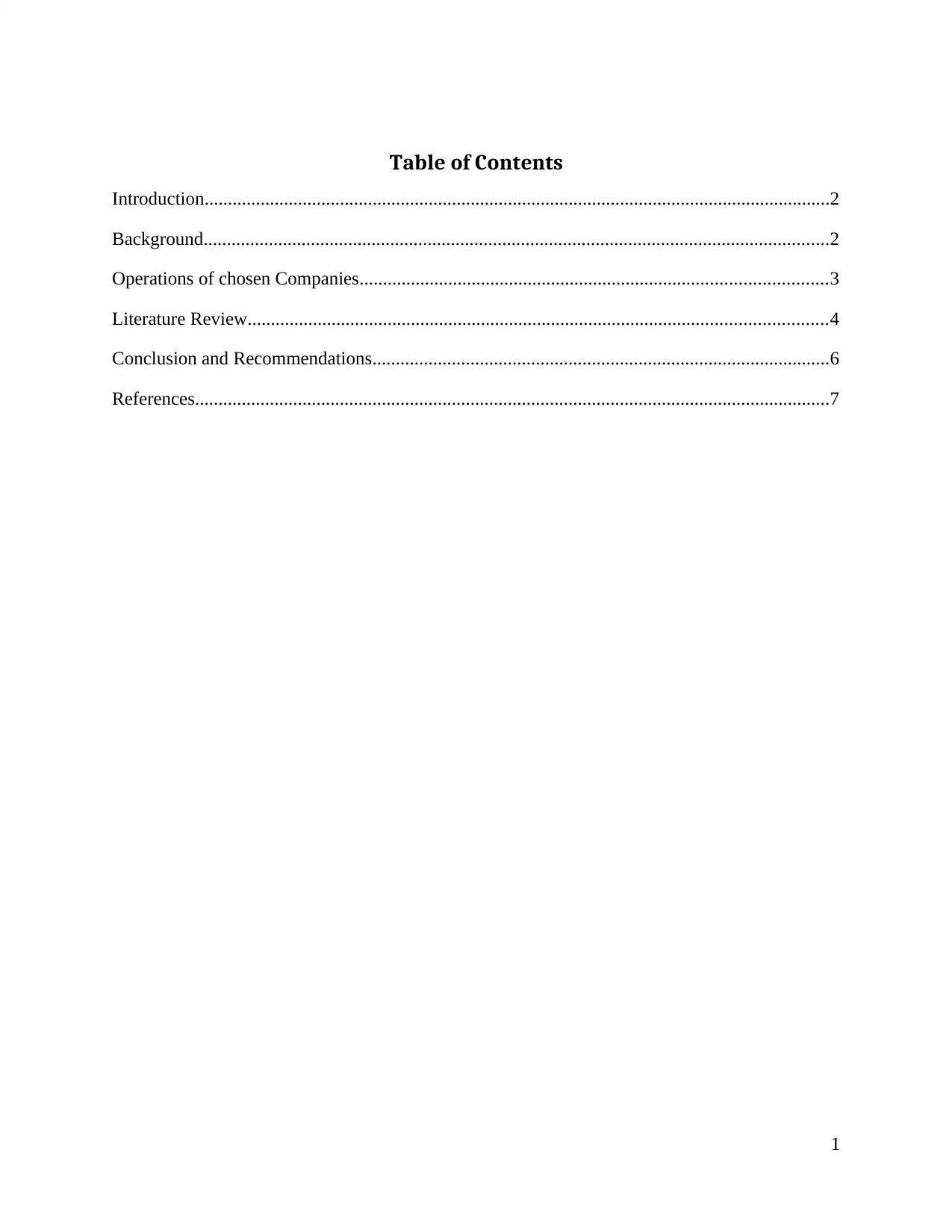
Table of Contents
Introduction......................................................................................................................................2
Background......................................................................................................................................2
Operations of chosen Companies....................................................................................................3
Literature Review............................................................................................................................4
Conclusion and Recommendations..................................................................................................6
References........................................................................................................................................7
1
Introduction......................................................................................................................................2
Background......................................................................................................................................2
Operations of chosen Companies....................................................................................................3
Literature Review............................................................................................................................4
Conclusion and Recommendations..................................................................................................6
References........................................................................................................................................7
1
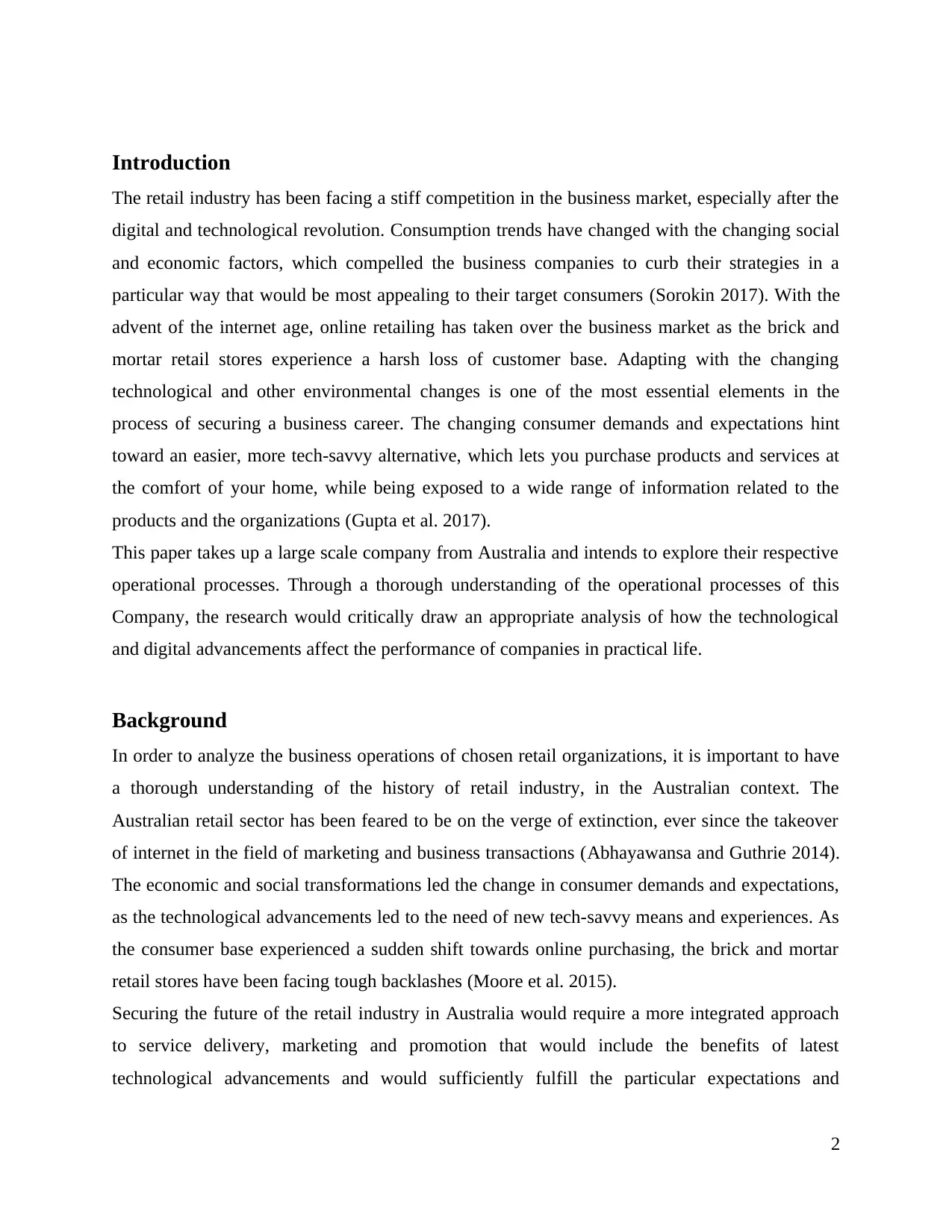
Introduction
The retail industry has been facing a stiff competition in the business market, especially after the
digital and technological revolution. Consumption trends have changed with the changing social
and economic factors, which compelled the business companies to curb their strategies in a
particular way that would be most appealing to their target consumers (Sorokin 2017). With the
advent of the internet age, online retailing has taken over the business market as the brick and
mortar retail stores experience a harsh loss of customer base. Adapting with the changing
technological and other environmental changes is one of the most essential elements in the
process of securing a business career. The changing consumer demands and expectations hint
toward an easier, more tech-savvy alternative, which lets you purchase products and services at
the comfort of your home, while being exposed to a wide range of information related to the
products and the organizations (Gupta et al. 2017).
This paper takes up a large scale company from Australia and intends to explore their respective
operational processes. Through a thorough understanding of the operational processes of this
Company, the research would critically draw an appropriate analysis of how the technological
and digital advancements affect the performance of companies in practical life.
Background
In order to analyze the business operations of chosen retail organizations, it is important to have
a thorough understanding of the history of retail industry, in the Australian context. The
Australian retail sector has been feared to be on the verge of extinction, ever since the takeover
of internet in the field of marketing and business transactions (Abhayawansa and Guthrie 2014).
The economic and social transformations led the change in consumer demands and expectations,
as the technological advancements led to the need of new tech-savvy means and experiences. As
the consumer base experienced a sudden shift towards online purchasing, the brick and mortar
retail stores have been facing tough backlashes (Moore et al. 2015).
Securing the future of the retail industry in Australia would require a more integrated approach
to service delivery, marketing and promotion that would include the benefits of latest
technological advancements and would sufficiently fulfill the particular expectations and
2
The retail industry has been facing a stiff competition in the business market, especially after the
digital and technological revolution. Consumption trends have changed with the changing social
and economic factors, which compelled the business companies to curb their strategies in a
particular way that would be most appealing to their target consumers (Sorokin 2017). With the
advent of the internet age, online retailing has taken over the business market as the brick and
mortar retail stores experience a harsh loss of customer base. Adapting with the changing
technological and other environmental changes is one of the most essential elements in the
process of securing a business career. The changing consumer demands and expectations hint
toward an easier, more tech-savvy alternative, which lets you purchase products and services at
the comfort of your home, while being exposed to a wide range of information related to the
products and the organizations (Gupta et al. 2017).
This paper takes up a large scale company from Australia and intends to explore their respective
operational processes. Through a thorough understanding of the operational processes of this
Company, the research would critically draw an appropriate analysis of how the technological
and digital advancements affect the performance of companies in practical life.
Background
In order to analyze the business operations of chosen retail organizations, it is important to have
a thorough understanding of the history of retail industry, in the Australian context. The
Australian retail sector has been feared to be on the verge of extinction, ever since the takeover
of internet in the field of marketing and business transactions (Abhayawansa and Guthrie 2014).
The economic and social transformations led the change in consumer demands and expectations,
as the technological advancements led to the need of new tech-savvy means and experiences. As
the consumer base experienced a sudden shift towards online purchasing, the brick and mortar
retail stores have been facing tough backlashes (Moore et al. 2015).
Securing the future of the retail industry in Australia would require a more integrated approach
to service delivery, marketing and promotion that would include the benefits of latest
technological advancements and would sufficiently fulfill the particular expectations and
2
⊘ This is a preview!⊘
Do you want full access?
Subscribe today to unlock all pages.

Trusted by 1+ million students worldwide
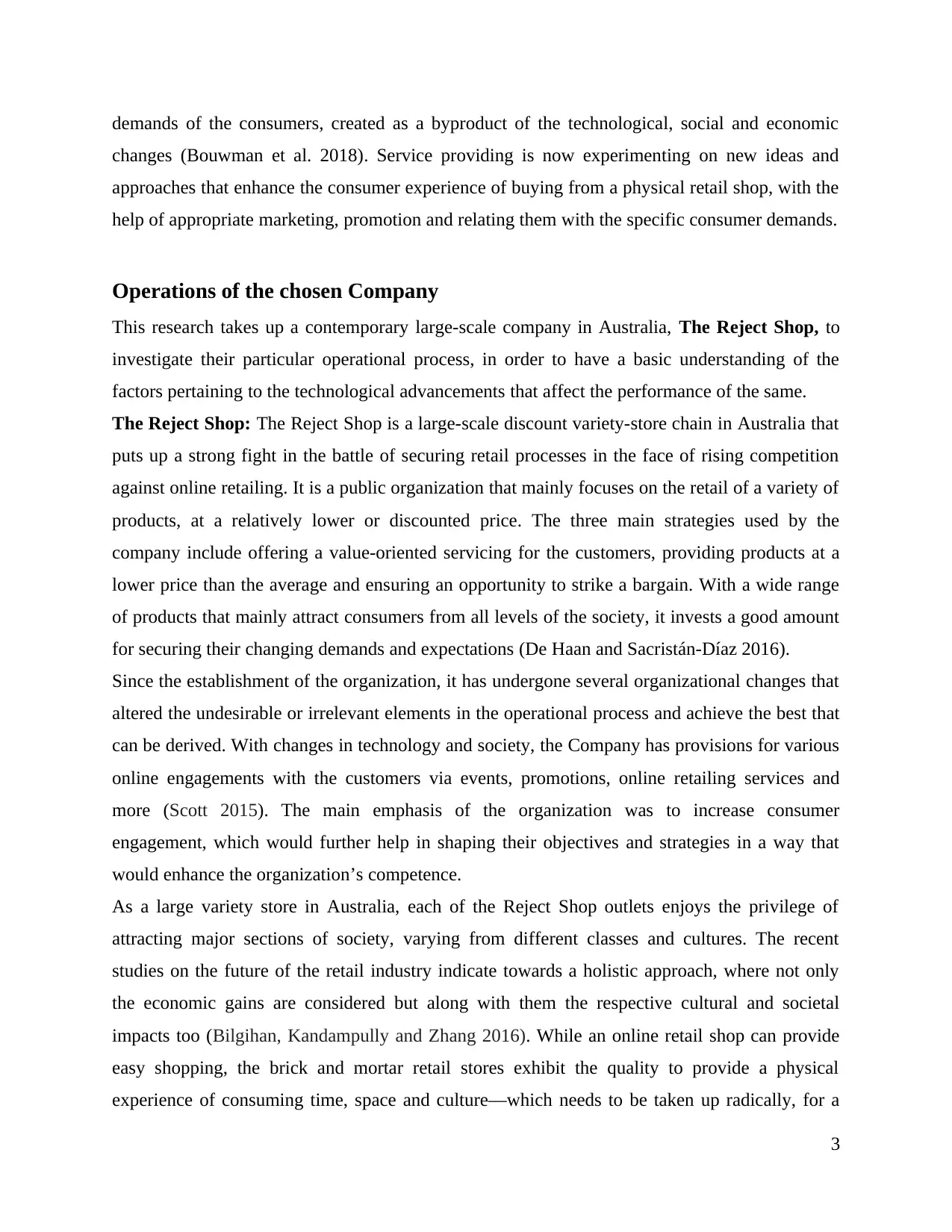
demands of the consumers, created as a byproduct of the technological, social and economic
changes (Bouwman et al. 2018). Service providing is now experimenting on new ideas and
approaches that enhance the consumer experience of buying from a physical retail shop, with the
help of appropriate marketing, promotion and relating them with the specific consumer demands.
Operations of the chosen Company
This research takes up a contemporary large-scale company in Australia, The Reject Shop, to
investigate their particular operational process, in order to have a basic understanding of the
factors pertaining to the technological advancements that affect the performance of the same.
The Reject Shop: The Reject Shop is a large-scale discount variety-store chain in Australia that
puts up a strong fight in the battle of securing retail processes in the face of rising competition
against online retailing. It is a public organization that mainly focuses on the retail of a variety of
products, at a relatively lower or discounted price. The three main strategies used by the
company include offering a value-oriented servicing for the customers, providing products at a
lower price than the average and ensuring an opportunity to strike a bargain. With a wide range
of products that mainly attract consumers from all levels of the society, it invests a good amount
for securing their changing demands and expectations (De Haan and Sacristán-Díaz 2016).
Since the establishment of the organization, it has undergone several organizational changes that
altered the undesirable or irrelevant elements in the operational process and achieve the best that
can be derived. With changes in technology and society, the Company has provisions for various
online engagements with the customers via events, promotions, online retailing services and
more (Scott 2015). The main emphasis of the organization was to increase consumer
engagement, which would further help in shaping their objectives and strategies in a way that
would enhance the organization’s competence.
As a large variety store in Australia, each of the Reject Shop outlets enjoys the privilege of
attracting major sections of society, varying from different classes and cultures. The recent
studies on the future of the retail industry indicate towards a holistic approach, where not only
the economic gains are considered but along with them the respective cultural and societal
impacts too (Bilgihan, Kandampully and Zhang 2016). While an online retail shop can provide
easy shopping, the brick and mortar retail stores exhibit the quality to provide a physical
experience of consuming time, space and culture—which needs to be taken up radically, for a
3
changes (Bouwman et al. 2018). Service providing is now experimenting on new ideas and
approaches that enhance the consumer experience of buying from a physical retail shop, with the
help of appropriate marketing, promotion and relating them with the specific consumer demands.
Operations of the chosen Company
This research takes up a contemporary large-scale company in Australia, The Reject Shop, to
investigate their particular operational process, in order to have a basic understanding of the
factors pertaining to the technological advancements that affect the performance of the same.
The Reject Shop: The Reject Shop is a large-scale discount variety-store chain in Australia that
puts up a strong fight in the battle of securing retail processes in the face of rising competition
against online retailing. It is a public organization that mainly focuses on the retail of a variety of
products, at a relatively lower or discounted price. The three main strategies used by the
company include offering a value-oriented servicing for the customers, providing products at a
lower price than the average and ensuring an opportunity to strike a bargain. With a wide range
of products that mainly attract consumers from all levels of the society, it invests a good amount
for securing their changing demands and expectations (De Haan and Sacristán-Díaz 2016).
Since the establishment of the organization, it has undergone several organizational changes that
altered the undesirable or irrelevant elements in the operational process and achieve the best that
can be derived. With changes in technology and society, the Company has provisions for various
online engagements with the customers via events, promotions, online retailing services and
more (Scott 2015). The main emphasis of the organization was to increase consumer
engagement, which would further help in shaping their objectives and strategies in a way that
would enhance the organization’s competence.
As a large variety store in Australia, each of the Reject Shop outlets enjoys the privilege of
attracting major sections of society, varying from different classes and cultures. The recent
studies on the future of the retail industry indicate towards a holistic approach, where not only
the economic gains are considered but along with them the respective cultural and societal
impacts too (Bilgihan, Kandampully and Zhang 2016). While an online retail shop can provide
easy shopping, the brick and mortar retail stores exhibit the quality to provide a physical
experience of consuming time, space and culture—which needs to be taken up radically, for a
3
Paraphrase This Document
Need a fresh take? Get an instant paraphrase of this document with our AI Paraphraser
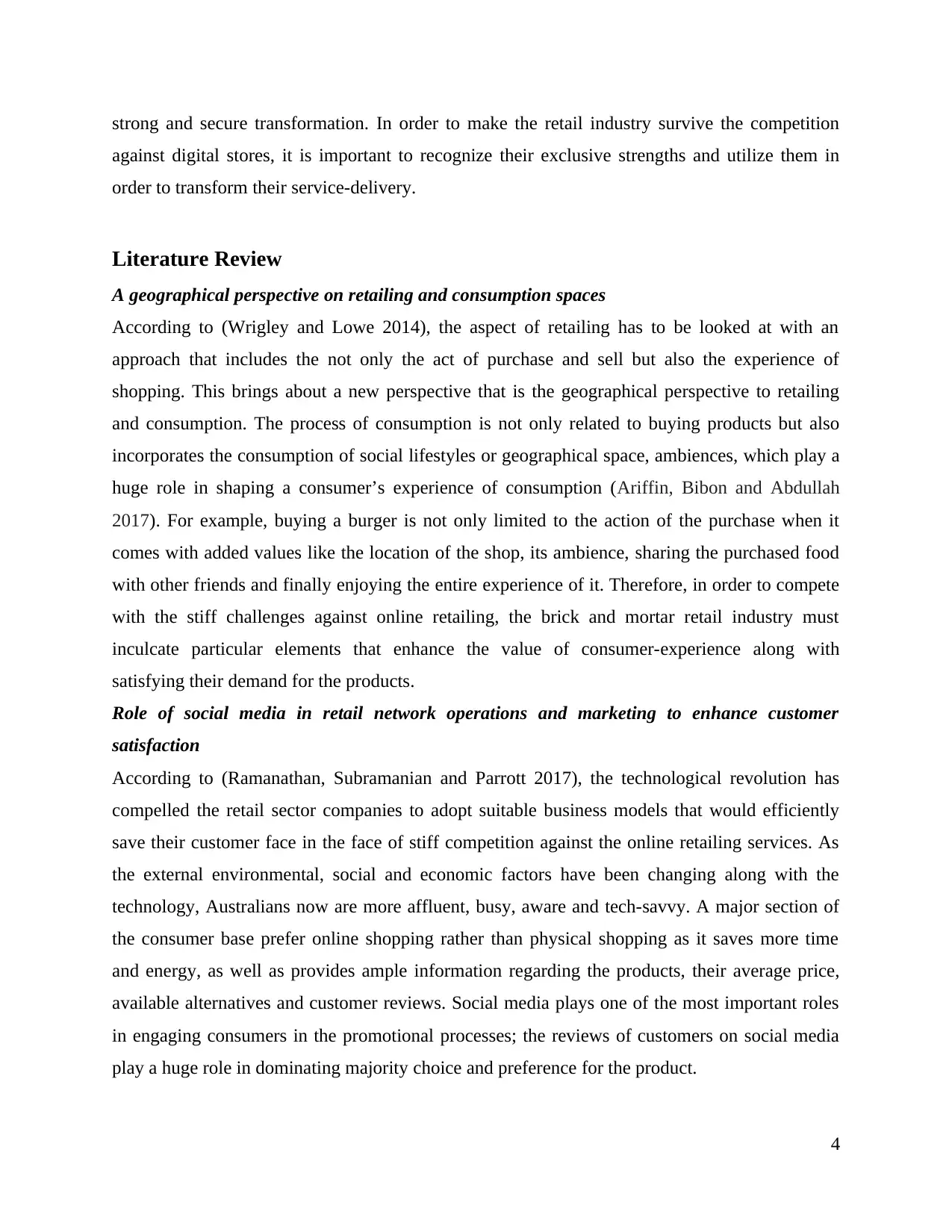
strong and secure transformation. In order to make the retail industry survive the competition
against digital stores, it is important to recognize their exclusive strengths and utilize them in
order to transform their service-delivery.
Literature Review
A geographical perspective on retailing and consumption spaces
According to (Wrigley and Lowe 2014), the aspect of retailing has to be looked at with an
approach that includes the not only the act of purchase and sell but also the experience of
shopping. This brings about a new perspective that is the geographical perspective to retailing
and consumption. The process of consumption is not only related to buying products but also
incorporates the consumption of social lifestyles or geographical space, ambiences, which play a
huge role in shaping a consumer’s experience of consumption (Ariffin, Bibon and Abdullah
2017). For example, buying a burger is not only limited to the action of the purchase when it
comes with added values like the location of the shop, its ambience, sharing the purchased food
with other friends and finally enjoying the entire experience of it. Therefore, in order to compete
with the stiff challenges against online retailing, the brick and mortar retail industry must
inculcate particular elements that enhance the value of consumer-experience along with
satisfying their demand for the products.
Role of social media in retail network operations and marketing to enhance customer
satisfaction
According to (Ramanathan, Subramanian and Parrott 2017), the technological revolution has
compelled the retail sector companies to adopt suitable business models that would efficiently
save their customer face in the face of stiff competition against the online retailing services. As
the external environmental, social and economic factors have been changing along with the
technology, Australians now are more affluent, busy, aware and tech-savvy. A major section of
the consumer base prefer online shopping rather than physical shopping as it saves more time
and energy, as well as provides ample information regarding the products, their average price,
available alternatives and customer reviews. Social media plays one of the most important roles
in engaging consumers in the promotional processes; the reviews of customers on social media
play a huge role in dominating majority choice and preference for the product.
4
against digital stores, it is important to recognize their exclusive strengths and utilize them in
order to transform their service-delivery.
Literature Review
A geographical perspective on retailing and consumption spaces
According to (Wrigley and Lowe 2014), the aspect of retailing has to be looked at with an
approach that includes the not only the act of purchase and sell but also the experience of
shopping. This brings about a new perspective that is the geographical perspective to retailing
and consumption. The process of consumption is not only related to buying products but also
incorporates the consumption of social lifestyles or geographical space, ambiences, which play a
huge role in shaping a consumer’s experience of consumption (Ariffin, Bibon and Abdullah
2017). For example, buying a burger is not only limited to the action of the purchase when it
comes with added values like the location of the shop, its ambience, sharing the purchased food
with other friends and finally enjoying the entire experience of it. Therefore, in order to compete
with the stiff challenges against online retailing, the brick and mortar retail industry must
inculcate particular elements that enhance the value of consumer-experience along with
satisfying their demand for the products.
Role of social media in retail network operations and marketing to enhance customer
satisfaction
According to (Ramanathan, Subramanian and Parrott 2017), the technological revolution has
compelled the retail sector companies to adopt suitable business models that would efficiently
save their customer face in the face of stiff competition against the online retailing services. As
the external environmental, social and economic factors have been changing along with the
technology, Australians now are more affluent, busy, aware and tech-savvy. A major section of
the consumer base prefer online shopping rather than physical shopping as it saves more time
and energy, as well as provides ample information regarding the products, their average price,
available alternatives and customer reviews. Social media plays one of the most important roles
in engaging consumers in the promotional processes; the reviews of customers on social media
play a huge role in dominating majority choice and preference for the product.
4
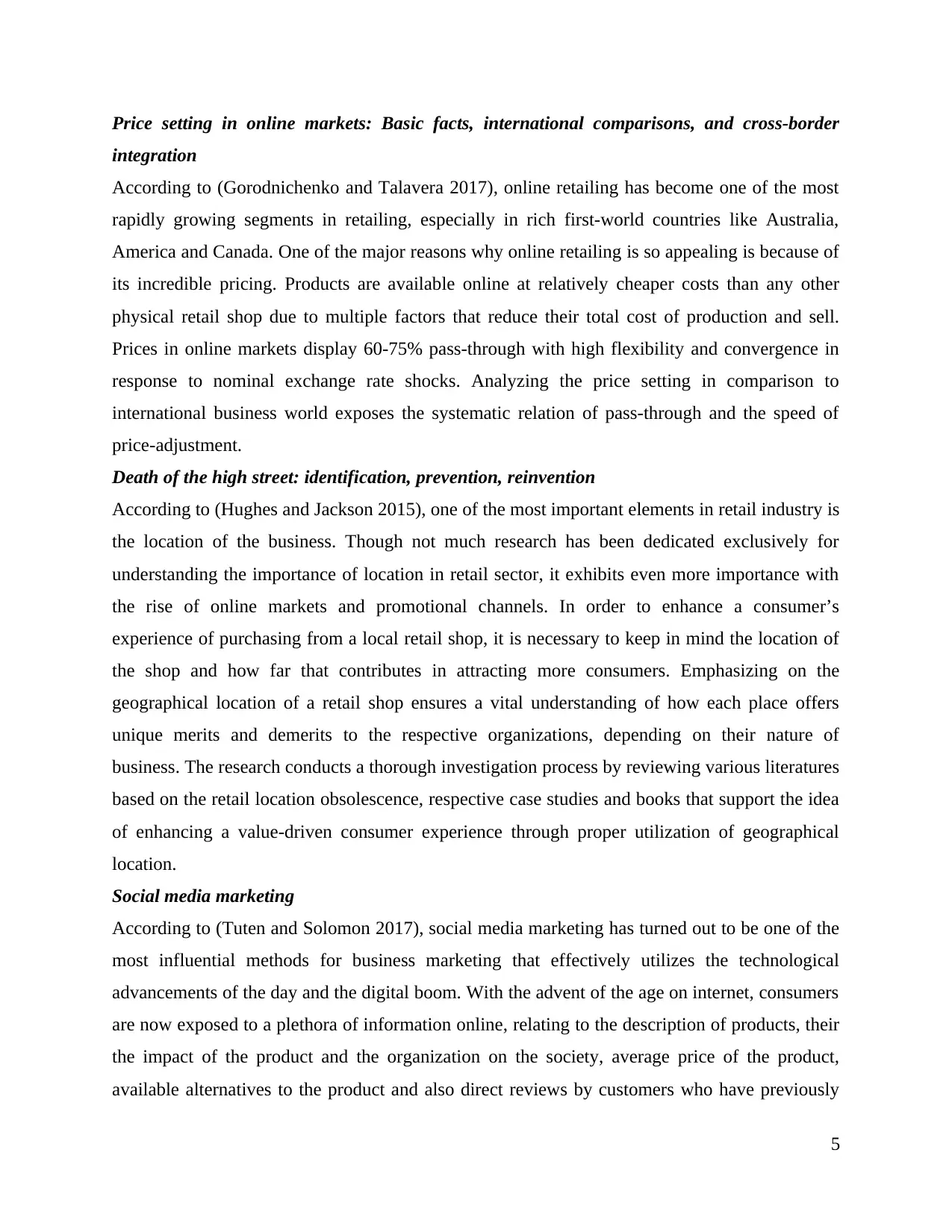
Price setting in online markets: Basic facts, international comparisons, and cross-border
integration
According to (Gorodnichenko and Talavera 2017), online retailing has become one of the most
rapidly growing segments in retailing, especially in rich first-world countries like Australia,
America and Canada. One of the major reasons why online retailing is so appealing is because of
its incredible pricing. Products are available online at relatively cheaper costs than any other
physical retail shop due to multiple factors that reduce their total cost of production and sell.
Prices in online markets display 60-75% pass-through with high flexibility and convergence in
response to nominal exchange rate shocks. Analyzing the price setting in comparison to
international business world exposes the systematic relation of pass-through and the speed of
price-adjustment.
Death of the high street: identification, prevention, reinvention
According to (Hughes and Jackson 2015), one of the most important elements in retail industry is
the location of the business. Though not much research has been dedicated exclusively for
understanding the importance of location in retail sector, it exhibits even more importance with
the rise of online markets and promotional channels. In order to enhance a consumer’s
experience of purchasing from a local retail shop, it is necessary to keep in mind the location of
the shop and how far that contributes in attracting more consumers. Emphasizing on the
geographical location of a retail shop ensures a vital understanding of how each place offers
unique merits and demerits to the respective organizations, depending on their nature of
business. The research conducts a thorough investigation process by reviewing various literatures
based on the retail location obsolescence, respective case studies and books that support the idea
of enhancing a value-driven consumer experience through proper utilization of geographical
location.
Social media marketing
According to (Tuten and Solomon 2017), social media marketing has turned out to be one of the
most influential methods for business marketing that effectively utilizes the technological
advancements of the day and the digital boom. With the advent of the age on internet, consumers
are now exposed to a plethora of information online, relating to the description of products, their
the impact of the product and the organization on the society, average price of the product,
available alternatives to the product and also direct reviews by customers who have previously
5
integration
According to (Gorodnichenko and Talavera 2017), online retailing has become one of the most
rapidly growing segments in retailing, especially in rich first-world countries like Australia,
America and Canada. One of the major reasons why online retailing is so appealing is because of
its incredible pricing. Products are available online at relatively cheaper costs than any other
physical retail shop due to multiple factors that reduce their total cost of production and sell.
Prices in online markets display 60-75% pass-through with high flexibility and convergence in
response to nominal exchange rate shocks. Analyzing the price setting in comparison to
international business world exposes the systematic relation of pass-through and the speed of
price-adjustment.
Death of the high street: identification, prevention, reinvention
According to (Hughes and Jackson 2015), one of the most important elements in retail industry is
the location of the business. Though not much research has been dedicated exclusively for
understanding the importance of location in retail sector, it exhibits even more importance with
the rise of online markets and promotional channels. In order to enhance a consumer’s
experience of purchasing from a local retail shop, it is necessary to keep in mind the location of
the shop and how far that contributes in attracting more consumers. Emphasizing on the
geographical location of a retail shop ensures a vital understanding of how each place offers
unique merits and demerits to the respective organizations, depending on their nature of
business. The research conducts a thorough investigation process by reviewing various literatures
based on the retail location obsolescence, respective case studies and books that support the idea
of enhancing a value-driven consumer experience through proper utilization of geographical
location.
Social media marketing
According to (Tuten and Solomon 2017), social media marketing has turned out to be one of the
most influential methods for business marketing that effectively utilizes the technological
advancements of the day and the digital boom. With the advent of the age on internet, consumers
are now exposed to a plethora of information online, relating to the description of products, their
the impact of the product and the organization on the society, average price of the product,
available alternatives to the product and also direct reviews by customers who have previously
5
⊘ This is a preview!⊘
Do you want full access?
Subscribe today to unlock all pages.

Trusted by 1+ million students worldwide
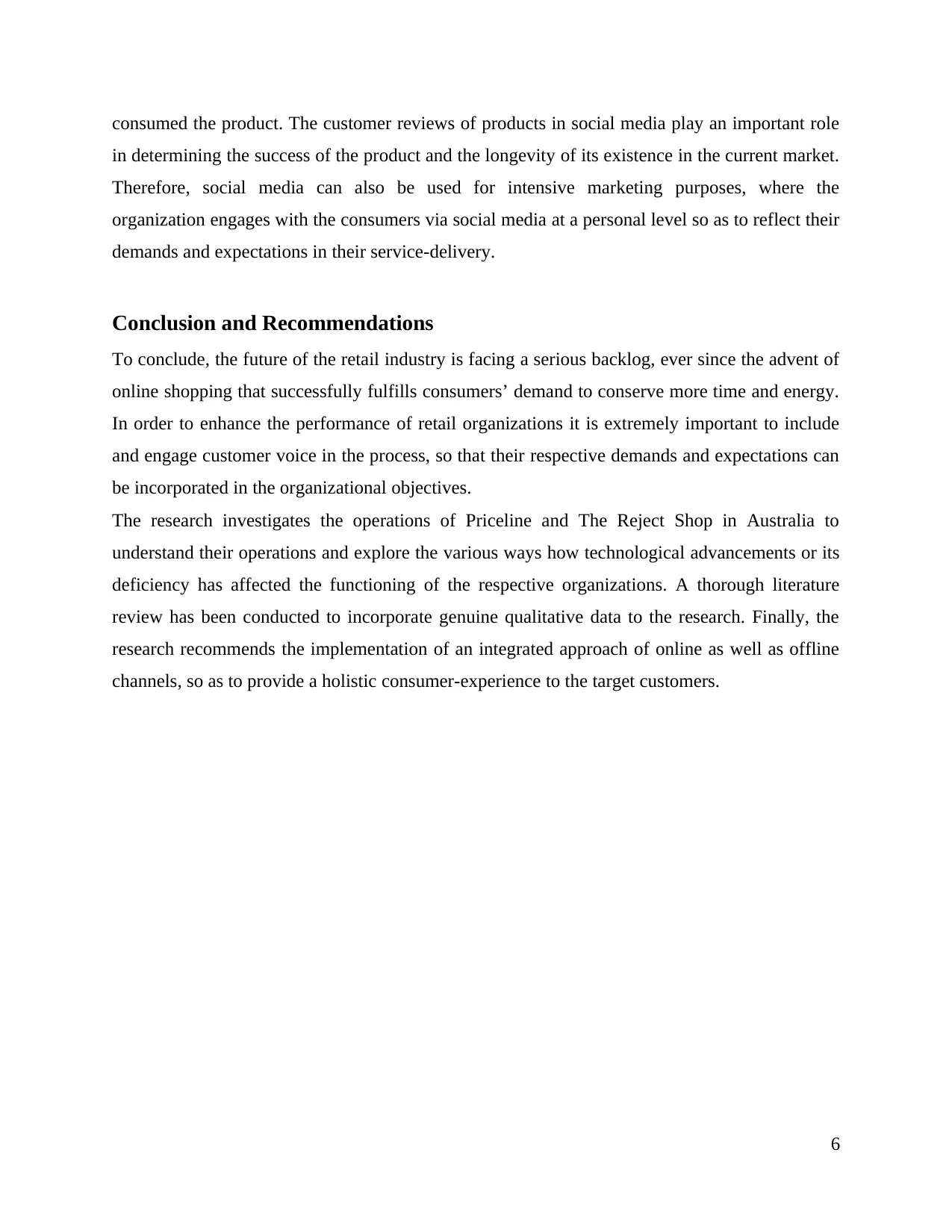
consumed the product. The customer reviews of products in social media play an important role
in determining the success of the product and the longevity of its existence in the current market.
Therefore, social media can also be used for intensive marketing purposes, where the
organization engages with the consumers via social media at a personal level so as to reflect their
demands and expectations in their service-delivery.
Conclusion and Recommendations
To conclude, the future of the retail industry is facing a serious backlog, ever since the advent of
online shopping that successfully fulfills consumers’ demand to conserve more time and energy.
In order to enhance the performance of retail organizations it is extremely important to include
and engage customer voice in the process, so that their respective demands and expectations can
be incorporated in the organizational objectives.
The research investigates the operations of Priceline and The Reject Shop in Australia to
understand their operations and explore the various ways how technological advancements or its
deficiency has affected the functioning of the respective organizations. A thorough literature
review has been conducted to incorporate genuine qualitative data to the research. Finally, the
research recommends the implementation of an integrated approach of online as well as offline
channels, so as to provide a holistic consumer-experience to the target customers.
6
in determining the success of the product and the longevity of its existence in the current market.
Therefore, social media can also be used for intensive marketing purposes, where the
organization engages with the consumers via social media at a personal level so as to reflect their
demands and expectations in their service-delivery.
Conclusion and Recommendations
To conclude, the future of the retail industry is facing a serious backlog, ever since the advent of
online shopping that successfully fulfills consumers’ demand to conserve more time and energy.
In order to enhance the performance of retail organizations it is extremely important to include
and engage customer voice in the process, so that their respective demands and expectations can
be incorporated in the organizational objectives.
The research investigates the operations of Priceline and The Reject Shop in Australia to
understand their operations and explore the various ways how technological advancements or its
deficiency has affected the functioning of the respective organizations. A thorough literature
review has been conducted to incorporate genuine qualitative data to the research. Finally, the
research recommends the implementation of an integrated approach of online as well as offline
channels, so as to provide a holistic consumer-experience to the target customers.
6
Paraphrase This Document
Need a fresh take? Get an instant paraphrase of this document with our AI Paraphraser
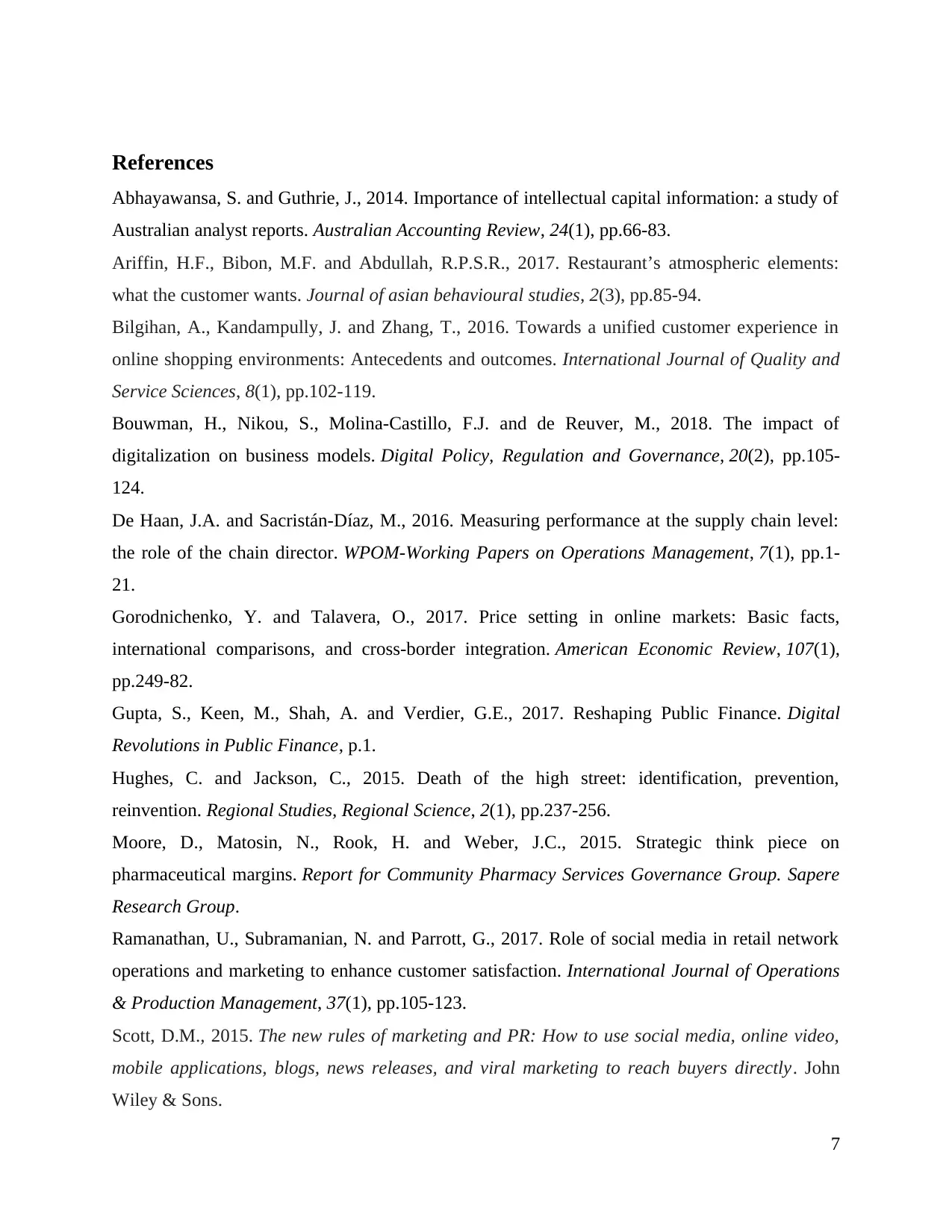
References
Abhayawansa, S. and Guthrie, J., 2014. Importance of intellectual capital information: a study of
Australian analyst reports. Australian Accounting Review, 24(1), pp.66-83.
Ariffin, H.F., Bibon, M.F. and Abdullah, R.P.S.R., 2017. Restaurant’s atmospheric elements:
what the customer wants. Journal of asian behavioural studies, 2(3), pp.85-94.
Bilgihan, A., Kandampully, J. and Zhang, T., 2016. Towards a unified customer experience in
online shopping environments: Antecedents and outcomes. International Journal of Quality and
Service Sciences, 8(1), pp.102-119.
Bouwman, H., Nikou, S., Molina-Castillo, F.J. and de Reuver, M., 2018. The impact of
digitalization on business models. Digital Policy, Regulation and Governance, 20(2), pp.105-
124.
De Haan, J.A. and Sacristán-Díaz, M., 2016. Measuring performance at the supply chain level:
the role of the chain director. WPOM-Working Papers on Operations Management, 7(1), pp.1-
21.
Gorodnichenko, Y. and Talavera, O., 2017. Price setting in online markets: Basic facts,
international comparisons, and cross-border integration. American Economic Review, 107(1),
pp.249-82.
Gupta, S., Keen, M., Shah, A. and Verdier, G.E., 2017. Reshaping Public Finance. Digital
Revolutions in Public Finance, p.1.
Hughes, C. and Jackson, C., 2015. Death of the high street: identification, prevention,
reinvention. Regional Studies, Regional Science, 2(1), pp.237-256.
Moore, D., Matosin, N., Rook, H. and Weber, J.C., 2015. Strategic think piece on
pharmaceutical margins. Report for Community Pharmacy Services Governance Group. Sapere
Research Group.
Ramanathan, U., Subramanian, N. and Parrott, G., 2017. Role of social media in retail network
operations and marketing to enhance customer satisfaction. International Journal of Operations
& Production Management, 37(1), pp.105-123.
Scott, D.M., 2015. The new rules of marketing and PR: How to use social media, online video,
mobile applications, blogs, news releases, and viral marketing to reach buyers directly. John
Wiley & Sons.
7
Abhayawansa, S. and Guthrie, J., 2014. Importance of intellectual capital information: a study of
Australian analyst reports. Australian Accounting Review, 24(1), pp.66-83.
Ariffin, H.F., Bibon, M.F. and Abdullah, R.P.S.R., 2017. Restaurant’s atmospheric elements:
what the customer wants. Journal of asian behavioural studies, 2(3), pp.85-94.
Bilgihan, A., Kandampully, J. and Zhang, T., 2016. Towards a unified customer experience in
online shopping environments: Antecedents and outcomes. International Journal of Quality and
Service Sciences, 8(1), pp.102-119.
Bouwman, H., Nikou, S., Molina-Castillo, F.J. and de Reuver, M., 2018. The impact of
digitalization on business models. Digital Policy, Regulation and Governance, 20(2), pp.105-
124.
De Haan, J.A. and Sacristán-Díaz, M., 2016. Measuring performance at the supply chain level:
the role of the chain director. WPOM-Working Papers on Operations Management, 7(1), pp.1-
21.
Gorodnichenko, Y. and Talavera, O., 2017. Price setting in online markets: Basic facts,
international comparisons, and cross-border integration. American Economic Review, 107(1),
pp.249-82.
Gupta, S., Keen, M., Shah, A. and Verdier, G.E., 2017. Reshaping Public Finance. Digital
Revolutions in Public Finance, p.1.
Hughes, C. and Jackson, C., 2015. Death of the high street: identification, prevention,
reinvention. Regional Studies, Regional Science, 2(1), pp.237-256.
Moore, D., Matosin, N., Rook, H. and Weber, J.C., 2015. Strategic think piece on
pharmaceutical margins. Report for Community Pharmacy Services Governance Group. Sapere
Research Group.
Ramanathan, U., Subramanian, N. and Parrott, G., 2017. Role of social media in retail network
operations and marketing to enhance customer satisfaction. International Journal of Operations
& Production Management, 37(1), pp.105-123.
Scott, D.M., 2015. The new rules of marketing and PR: How to use social media, online video,
mobile applications, blogs, news releases, and viral marketing to reach buyers directly. John
Wiley & Sons.
7

Sorokin, P., 2017. Social and cultural dynamics: A study of change in major systems of art, truth,
ethics, law and social relationships. Routledge. London, UK
Tuten, T.L. and Solomon, M.R., 2017. Social media marketing. Sage.
Wrigley, N. and Lowe, M., 2014. Reading retail: A geographical perspective on retailing and
consumption spaces. Routledge. London, UK
8
ethics, law and social relationships. Routledge. London, UK
Tuten, T.L. and Solomon, M.R., 2017. Social media marketing. Sage.
Wrigley, N. and Lowe, M., 2014. Reading retail: A geographical perspective on retailing and
consumption spaces. Routledge. London, UK
8
⊘ This is a preview!⊘
Do you want full access?
Subscribe today to unlock all pages.

Trusted by 1+ million students worldwide
1 out of 9
Related Documents
Your All-in-One AI-Powered Toolkit for Academic Success.
+13062052269
info@desklib.com
Available 24*7 on WhatsApp / Email
![[object Object]](/_next/static/media/star-bottom.7253800d.svg)
Unlock your academic potential
Copyright © 2020–2025 A2Z Services. All Rights Reserved. Developed and managed by ZUCOL.




